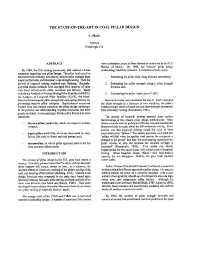Mining Publication: The State-of-the-Art in Coal Pillar Design
Original creation date: March 1999
By 1980, the U.S. mining community had reached a broad consensus regarding coal pillar design. The pillar load could be estimated from the tributary area theory, and the pillar strength from empirical formulas and laboratory coal strength testing. Then the growth of longwall mining required new thinking. Recently, powerful design methods have emerged from analysis of large data bases of real-world pillar successes and failures. These include the Analysis of Retreat Mining Pillar Stability (ARMPS), the Analysis of Longwall Pillar Stability (ALPS), the Mark-Bieniawski rectangular pillar strength formula, and guidelines for preventing massive pillar collapses. Sophisticated numerical models have also helped transform the pillar design landscape. In the process, our understanding of pillar mechanics has been greatly enriched. A new paradigm divides pillar failure into three categories: Slender pillars (w/h<3.0), which are subject to sudden collapse; squat pillars (w/h>10), which are dominated by entry failure (rib, roof, or floor) and coal bumps, and; intermediate, in which pillar squeezes seem to be the most common failure mode.
Authors: C Mark
Conference Paper - March 1999
NIOSHTIC2 Number: 20025330
SME Preprint 99-86. Littleton, CO: Society for Mining, Metallurgy, and Exploration, Inc., 1999 Mar; :1-8
See Also
- ARMPS - Analysis of Retreat Mining Pillar Stability - 6.2.02
- Critical Review of Numerical Stress Analysis Tools for Deep Coal Longwall Panels Under Strong Strata
- Degasification System Selection for U.S. Longwall Mines Using an Expert Classification System
- Elastic and Shear Moduli of Coal Measure Rocks Derived from Basic Well Logs Using Fractal Statistics and Radial Basis Functions
- Ground Control Research: Considering Local Geology to Improve Longwall Pillar Stability
- Numerical Modeling Procedures for Practical Coal Mine Design
- Predicting Methane Emissions from Longer Longwall Faces by Analysis of Emission Contributors
- Proceedings: New Technology for Ground Control in Retreat Mining
- Technology News 464 - Analysis of Retreat Mining Pillar Stability (ARMPS): Version 4.0 for Windows
- Using the Coal Mine Roof Rating (CMRR) to Assess Roof Stability in U.S. Coal Mines
- Page last reviewed: 9/21/2012
- Page last updated: 9/21/2012
- Content source: National Institute for Occupational Safety and Health, Mining Program


 ShareCompartir
ShareCompartir
